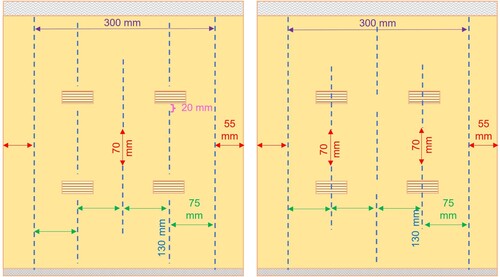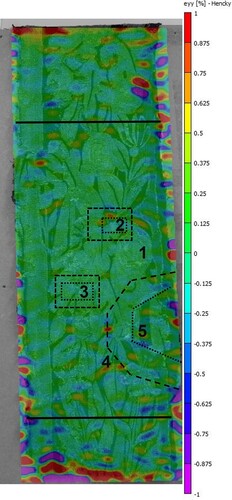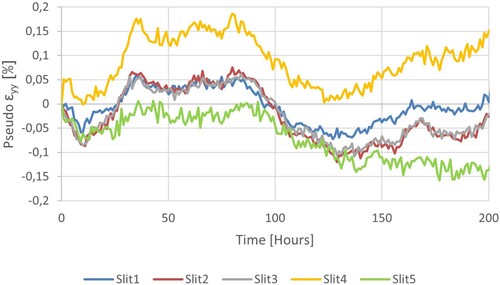ABSTRACT
This paper reports on an investigation into stitching techniques used to secure woven tapestry artefacts to fabric supports. A research project used digital image correlation (DIC) as a method of evaluating commonly used tapestry support techniques, with stitching tests carried out on wool rep fabric and a historic tapestry fragment. Though it was necessary to first establish parameters for use, DIC proved very helpful for evaluating the effects of these treatments. It demonstrated that damage leads to high levels of deformation and strain, and that extension and creep are mitigated by stitched support. It was shown that a patch support gives good results if the tapestry is damaged in a discrete area, while a full fabric support provides better overall support for weak areas, even if they are not themselves stitched to the support fabric. In general, it was clear that the closer the stitching, the lower the strain. However, comparing global and local strain showed that very closely spaced stitching constrained the stitched area more than the sample overall. This investigation suggests that it is not necessary to carry out intensive stitching to provide good overall support. DIC could allow us to optimise the amount of stitching necessary for a successful support treatment of a tapestry, though further treatment may be carried out to provide visual compensation for loss. It was concluded that both a full stitched support and a partial stitched support in combination with a fabric-covered vertical mount provide effective reinforcement.
Introduction
It is notable that tapestry conservators in Europe and the USA employ a considerable range of stitching techniques to conserve woven tapestry; this was seen, for example, when drawing together contributions to the volume Tapestry Conservation: Principles and Practice (Lennard and Hayward Citation2006) and continues to be demonstrated in more recent publications (Brosens and Maes-de Wit Citation2019; Marko Citation2020). The choice of technique appears to be primarily dictated by custom and practice, with different choices, presumably derived from conservators’ training, in different areas of the world. These stitching methodologies are often complex, designed to meet both structural support requirements, and also the visual re-integration of missing or damaged parts of the image. Tapestry conservation is generally therefore an extremely time-consuming and resource-intensive undertaking – tapestries are often large and often in poor condition, requiring months or years of work – hence there is a desire to investigate whether we are using the most appropriate techniques. To date, there has been little objective investigation into the effectiveness of different tapestry conservation stitching techniques, although a paper by Asai et al. (Citation2008) is a notable exception. That paper reported on an investigation employing tensile testing to examine the effectiveness of stabilising stitch lines and close couching stitches used to support artificially damaged samples of tapestry weave material onto a linen support fabric. The authors concluded that ‘apart from the sample with minimal stitching, all other conservation methodologies had a significant stabilising effect on the elongation in the damaged area of the tapestry samples’ (Asai et al. Citation2008, 972). In addition, other authors have looked more broadly at the mechanical effects of conservation stitching techniques more commonly used on other types of textiles: Benson, Lennard, and Smith (Citation2014), Nilsson (Citation2015), Schön (Citation2017), and Sutherland and Lennard (Citation2017) all considered mechanical aspects of support stitching.
A recent research project at the University of Glasgow set out to make a contribution to this investigation by employing digital image correlation (DIC) as a means of comparing the effectiveness of different tapestry conservation stitching techniques. The three-year project, From the Golden Age to the Digital Age: Modelling and Monitoring Historic Tapestries, was funded by the Leverhulme Trust (2016–2020) and was a partnership between the Centre for Textile Conservation and Technical Art HistoryFootnote1 and the School of Engineering.Footnote2 It allowed an extensive series of tests to be carried out on tapestry support stitching, in comparison with those described in other published studies. The project also used DIC as a means of evaluating tapestry display on slanted supports (Costantini et al. Citation2020; Lennard, Costantini, and Harrison Citation2020). However it was necessary to begin by establishing parameters for the application of this technique to tapestry, building on work carried out at the University of Southampton in 2006–2010.Footnote3 DIC is a means of measuring strain (or percentage deformation); images are taken with one camera (2D DIC) or a pair of synchronised cameras (3D DIC) and are interrogated by computer software to measure extension and deformation over time. This technique provides quantitative data in the form of globally averaged displacement and strain measurements that can be conveniently visualised using full-field strain maps. Both were found to be useful for providing objective information on the effect of stitching, following a series of trials to establish appropriate parameters for the use of DIC with tapestry (Alsayednoor et al. Citation2019). Information on the initial development of this technique for monitoring tapestry can be found in Lennard and Dulieu-Barton (Citation2014) and details of the set-up for DIC in this project are included in Lennard, Costantini, and Harrison (Citation2021, 1–2).
The type of tapestry hanging which was the subject of this investigation is a hand-woven textile. Tapestry weave is a weft-faced plain (or tabby) weave, where the discontinuous coloured, weft yarns completely cover the much thicker, undyed warp yarns to form the image. Historic tapestries usually hang with the weft yarns oriented vertically and the thicker warp yarns running horizontally. Different techniques were employed historically to join the wefts where they changed colour. Slits were often left in the weaving and, although some were deliberately left unstitched by the weaver to exploit the difference in light and shade this created, the majority were closed by stitching; this introduced areas of weakness as the stitching deteriorated over time.
In order to evaluate the effectiveness of different conservation methods, it was necessary to define the goal of support stitching – what does it aim to achieve? The investigation described here set out only to investigate the physical support of tapestry (although some tapestry conservation techniques have a dual aim, using stitching in appropriately coloured yarns to both support the tapestry structure and to simultaneously re-define the tapestry image). Research has shown that tapestries are affected by two mechanical deterioration mechanisms: fatigue, caused by repeated expansion and contraction of the fibres in response to changing relative humidity (RH), and creep, or permanent deformation, which is time-dependent (Lennard and Dulieu-Barton Citation2014; Bratasz et al. Citation2014; Costantini et al. Citation2020). It is clear that damaged areas, such as open slits, are particularly prone to the effects of creep due to associated stress concentrations. To combat this a stitched support aims to provide physical support, overall or in damaged areas alone, to prevent weak and damaged areas from opening up under the tapestry’s weight. This aims to stabilise the tapestry’s physical condition and prevent further damage, allowing it to be displayed and stored safely.
The role of fatigue in causing long-term damage is still unclear. Tapestries’ large size – they may be several metres in width and height – mean that they are often on open display and subject to changes in RH which cause repeated expansion and contraction of the textile fibres, even in the relatively controlled conditions of a museum. This causes internal stresses when different parts of the tapestry expand and contract at different rates due to the use of different materials or techniques. While stable temperature and RH can minimise this, support materials are also often selected to accommodate the movement of the tapestry and continue to provide support as it expands and contracts. In practice linen or cotton is nearly always used as a support fabric, as demonstrated, for example, in the survey carried out by Hofenk de Graaff, Boersma, and Roelofs (Citation1998). Marko (Citation2020, 103) explained that ‘Linen (flax) is not only a strong fibre but has proved to be compatible with the ‘natural’ movements in a tapestry, which occur in response to fluctuations in relative humidity’. Although the impact of fatigue on long-term deterioration is still difficult to quantify, Bratasz et al. concluded that it is unlikely to be substantial (Citation2014).
Experimental work: stitching tests
A series of tests was carried out to compare the effect of stitching methods typically employed in the UK and mainland Europe, as demonstrated in a questionnaire compiled by Catic for her dissertation research on tapestry conservation techniques (Citation2019): comparing brick and laid couching; comparing different spacing of brick and laid couching; examining the effect of staggered support lines; and comparing patch and full supports. There are no standard guidelines for evaluating conservation practices, but the tests were partially based on those carried out earlier by Benson, Lennard, and Smith (Citation2014), Schön (Citation2017), and Sutherland and Lennard (Citation2017). The experimental design aimed to limit the number of variables being considered in each set of tests. The number of tests that could be carried out was limited by the time taken to carry out the stitching, but the tests were planned, and the samples evaluated, to gain as much information as possible. The stitching was mainly worked on samples of new wool rep fabric, which has a similar ribbed plain-weave structure, instead of woven tapestry.Footnote4 The use of aged historic tapestry samples would not have allowed a direct comparison of the results from one sample to another because of variability in the yarn count, materials, and condition, while resourcing constraints prevented the purchase of newly woven tapestry samples. The rep fabric was artificially damaged to replicate typical damage found in historic tapestries. It was not artificially aged as this would have introduced further variables, and the core aim of the tests was to investigate the effects of the different stitch types and patterns. The samples were supported onto washed linen scrim fabric. In all tests, couching stitching was worked with two strands from a stranded cotton thread; support lines were worked in polyester thread (please see below for specifications and suppliers’ details).
The stitched samples were suspended from the top edge against a vertical board for 168 h (one week) in each test. A speckle pattern was applied to the wool rep with dots from black fibre-tip pensFootnote5 as a registration device for the DIC system (seen in ). The rep samples were weighted so that the weight per m2 was more similar to actual tapestry, with 100 g or 200 g lead weights (depending on sample size) enclosed within a strip of fabric stitched to the bottom edge of the sample. There was no environmental control in the room used for monitoring but a Hanwell Pro ML4000 data logger was set to record the temperature and RH every 15 min. The samples were monitored by taking an image once per hour using a single camera, a Cannon EOS 1000D.Footnote6 The images were interrogated with Vic-2D softwareFootnote7 to provide strain maps and strain data, and these were used to evaluate the impact of stitching on the samples.Footnote8 A final trial on a historic tapestry fragment was also conducted, to ensure the results of the tests were also applicable to actual tapestry. In this case, the tapestry design itself acted as the registration pattern for the DIC. The tapestry was put under slight tension on a stitching frame to carry out the support stitching in order to ensure the warp yarns were straight, replicating usual tapestry conservation practice. Tension was not applied to the rep samples during stitching. This paper provides details of key tests only; full details of the suite of 11 tests carried out on the wool rep samples and all other tests are reported in Costantini’s PhD thesis (Citation2021).
Figure 1. Brick couching (left) and laid couching (right), both at 4 mm spacing, on wool rep fabric. The artificial damage has been created by removing some of the rep’s vertical warp yarns, representing tapestry weft yarns. The images also show the speckle pattern used for DIC registration.

Methodology
Test A: comparison of brick couching and laid couching at 4, 8, and 16 mm spacing
This test aimed to compare two types of intensive stitching used to secure damaged areas of a tapestry to a support fabric, and to examine the impact of stitching spacing. Brick couching has been a commonly used technique for tapestry support in the UK since its introduction in the 1960s (Bosworth and Clark Citation2006). It is effective in providing structural support and visual reintegration simultaneously and generally uses threads which are colour-matched to the tapestry weft to secure the tapestry warp yarns to a support fabric, with the stitching passing over alternate warps in a brick pattern. Laid couching is commonly used in mainland Europe, particularly in German-speaking countries, for stitching a tapestry to a support fabric (Catic Citation2019). This technique, widely used by textile conservators for many other types of textiles, lays down long lines of thread. Short perpendicular stitches are used to attach, or couch, the threads to the substrate, creating a supportive lattice rather than directly securing the tapestry warp yarns. shows brick and laid couching stitching.
Six pieces of rep fabric measuring 350 × 205 mm were artificially damaged by removing the vertical yarns, representing the tapestry weft,Footnote9 in an area of 55 × 15 mm ( and , left). Patches of linen fabric were stitched to the reverse of the damaged areas to secure the bare ‘tapestry warp’ yarns, using vertical rows of either brick or laid couching, at a range of spacings: rows of brick couching were worked 16 mm (sample A1), 8 mm (A2), and 4 mm (A3) apart. Laid couching rows were worked 16 mm (A4) and 8 mm (A5) apart.Footnote10 Examples of the stitches are shown in . The stitching was worked in a rectangular block with an equal number of stitches used in the two stitching types at the same spacing. The edges of the patches were not secured. A damaged, untreated sample was included in the test as a control (A6). The samples were weighted with 100 g lead weights.
Figure 2. Left: Wool rep sample measuring 350 × 205 mm used in test A. The brown lines show the area of artificial damage measuring 55 × 15 mm. Right: Wool rep sample measuring 650 × 410 mm used in tests B and C, with four areas of artificial damage. 50 mm at the top of each sample was used to clamp the fabric to a vertical board. Lead weights were enclosed within a strip of fabric stitched to the bottom edge.

Test B: examining the effect of staggered support lines, across areas of damage and between areas of damage
The second test aimed to investigate the effect of an overall support; in the UK it is probably more usual to treat a tapestry using an overall support of new fabric than to use patches. Textile conservators commonly use staggered running stitch support lines to secure a historic textile to a support fabric; it is a good means of providing overall reinforcement. Staggered lines of running stitches have sometimes been used as the primary technique to support tapestries in the UK, though generally in combination with a small amount of brick couching. Such details are rarely published, but Lennard and Harper (Citation2006) employed a grid of vertical lines of stitching on a sixteenth century tapestry to minimise the density of stitching overall, in part as a response to the very resource-intensive nature of the brick couching system.
In this test, two pieces of rep fabric measuring 650 × 410 mm were artificially damaged in the same way as in test A to create four areas of bare ‘warps’ on each sample (, right). Each rep sample was given a full support of linen fabric. This was attached to the rep with a vertical line of running stitches, or ‘scrim line’, at each side. In all such tests, the linen fabric was slightly looser than the rep – with 305 mm of linen to 300 mm of rep – replicating the slight excess of support fabric used in tapestry support stitching and intended to prevent the support fabric from becoming too tight after stitching is worked. On sample B1, staggered running stitch lines were worked around the areas of damage. On sample B2, staggered running stitch lines were worked through the areas of damage (). No couching stitching was worked in this test. A damaged, untreated sample was included as a control (B3). The samples were weighted with 200 g lead weights.
Test C: comparison of full and patched support, on more damaged sample
This test aimed to directly compare the effect of a full support with a patched support. Again, two pieces of rep fabric measuring 650 × 410 mm were artificially damaged to create four areas of bare ‘warp’ yarns on each piece. In order to replicate the condition of a ‘typical’ historic tapestry more closely, additional areas of damage were created in both the weft direction, on the left side of the fabric, and in the warp direction, on the right side (). In C1 the rep sample was given a full support of linen fabric with ‘scrim lines’and staggered support lines between the areas of damage; the main areas of damage were secured with brick couching at 8 mm spacing. In sample C2 stitching was limited to couching at 8 mm spacing onto localised patches behind the main areas of damage. In both cases, the surrounding areas of more minor damage were not stitched. A damaged, untreated sample was included in the test as a control (C3). The samples were weighted with 200 g lead weights.
Test D: tests on tapestry fragment
While data from the rep fabric samples proved useful, the researchers were also keen to test this methodology on an actual tapestry. A small tapestry fragment from the Centre’s Karen Finch Reference Collection had previously been used as an experimental resource in the research project. The fragment, which measured 1600 mm high x 400 mm wide, was in weak condition overall. It had suffered considerable damage and tapestry patches had been inserted at some point in its history. Areas of relatively high strain, shown in red on a strain map created before the tapestry was conserved (, left), indicated open slits and other areas of damage which had opened up as the unconserved tapestry was hung for a period of 200 h (Costantini et al. Citation2020, 9–13).
Figure 5. Left: Strain map of the tapestry after hanging for 200 h before conservation treatment. The red box shows the area where conservation treatments were subsequently applied. Centre: Reverse of the tapestry showing first conservation treatment, patched support. Brick couching stitching was carried out at 16 mm spacing (red box), 8 mm spacing (purple boxes), and 4 mm spacing (yellow boxes). Right: Reverse of the tapestry showing second conservation treatment, full support to lower half of the tapestry.
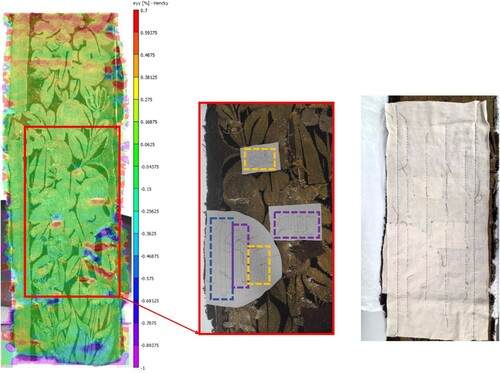
Part of the fragment was given a stitched support in two stages. Firstly three linen patches were applied behind major areas of damage in the lower half of the tapestry, which had appeared as red areas of high strain on the strain map. These were secured to the linen with brick couching, at different spacings – with rows at 16, 8, and 4 mm – as shown in , centre. The tapestry was then suspended vertically from the top edge against a board and monitored by DIC for 200 hours, with an image taken once an hour. Subsequently, a full support was applied behind the whole of the lower half of the tapestry, in addition to the patches. The full support was attached with two scrim lines, 300 mm apart, at each side of the tapestry, and between these with a grid of 130 mm long vertical support lines, spaced at 70 mm intervals vertically and 75 mm horizontally (, right).Footnote11 The tapestry was then suspended and monitored for a further 200 h.
Results of stitching tests
The DIC technique gave information in the form of globally averaged strain data, plotted on graphs of strain versus time, and full-field strain maps. The results shown are all measures of vertical strain (ϵyy); horizontal strain is not considered here as the main aim of stitching is to prevent vertical extension of damaged areas. The results demonstrate how damage leads to high displacements, which are recorded as apparent high strains. Where stitching restricted extension of the sample, this resulted in low strain measurements. It is important to note that while areas of extension across bare warps showed as red areas of relatively high strain on the strain maps (as seen in , A6), strain could not actually be measured in these areas; as the vertical yarns had been removed, there was no meaningful relationship between stress and strain (or load and deformation) in these regions. Nonetheless these clearly showed areas of concern for a textile conservator and the researchers referred to them as areas of ‘pseudo-strain’. Two types of strain data were examined: global or overall strain was measured by averaging strain across the whole sample area, whereas local strain (or pseudo-strain) was measured by averaging across the discrete area of damage. Global strain was generally found to be well correlated with RH, reflecting a gain in weight of the sample with increasing RH and a loss of weight with decreasing RH (though fibre swelling is also believed to play a role). By contrast, local strain was more time-dependent. As damaged areas opened up over time, the extension was not reversed with falling RH, instead showing permanent deformation, or creep.
Figure 6. Strain maps, ϵyy (%), after 168 h of monitoring of samples: A1, brick couching 16 mm; A2, brick couching 8 mm; A3, brick couching 4 mm; A4, laid couching 16 mm; A5, laid couching 8 mm; A6, damaged, untreated sample. Note the bright colours at the edges of the samples relate to errors in the DIC data, related to edge effects.

Test A: comparison of brick couching and laid couching at 16, 8, and 4 mm spacing
The strain maps from these samples showed clearly that any type of stitching prevented extension and strain. Only the unsupported sample, A6, showed high pseudo-strain, depicted in red, in the damaged area (). The global strain data shown on the graph in demonstrated the close relationship between strain and RH. They also showed that vertical strain (ϵyy) was higher in the unsupported sample, but also revealed more significant differences between the different stitched samples. As would be expected, these indicated that the closer the stitching, the lower the strain across the sample, as the extension was increasingly constrained. This is also shown in the graph of pseudo-strain data (), taken from just the damaged areas rather than from the sample overall. This demonstrated the occurrence of creep, rather than fatigue, in these areas. Interrogating these data more closely, global strain across the whole sample was compared with local strain across the areas of damage. This showed that, with stitching at 8 and 4 mm spacing, the local strain in the damaged area was lower than the globally averaged strain, meaning that the stitched area was more constrained than the surrounding area. However local and global strain were approximately equal for both laid and brick couching stitching at 16 mm spacing ().
Figure 7. Global longitudinal strain, ϵyy (%), during 168 h of monitoring samples: A1, brick couching 16 mm; A2, brick couching 8 mm; A3, brick couching 4 mm; A4, laid couching 16 mm; A5, laid couching 8 mm; A6, damaged, untreated sample. RH (%) is indicated by the dotted line.
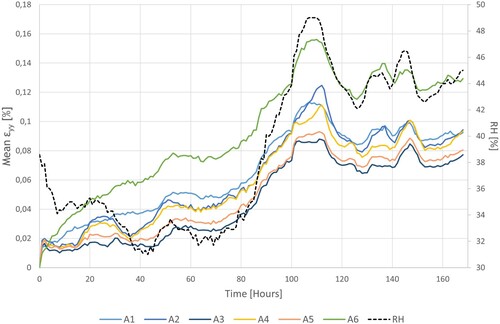
Figure 8. Pseudo-strain, ϵyy (%), across damaged areas of samples during 168 h of monitoring: A1, brick couching 16 mm; A2, brick couching 8 mm; A3, brick couching 4 mm; A4, laid couching 16 mm; A5, laid couching 8 mm; A6, damaged, untreated sample.
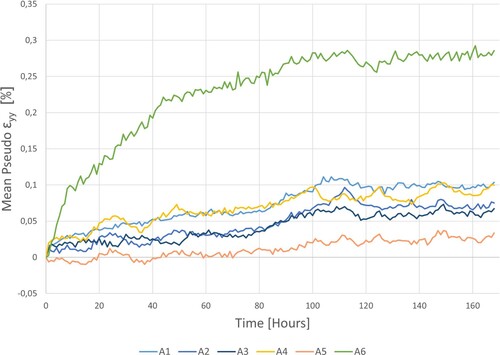
Figure 9. Comparison of global strain and pseudo-strain, ϵyy (%), across two samples during 168 h of monitoring: A1, brick couching 16 mm; A2, brick couching 8 mm.
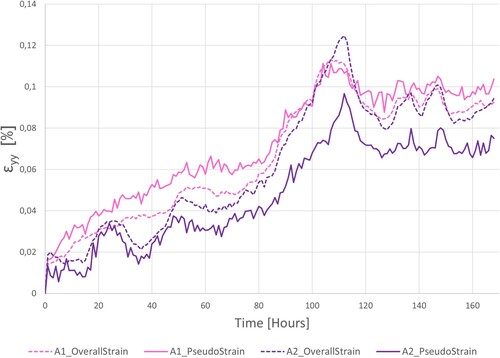
Looking more closely at the stitching techniques, it was apparent that strain was higher in the brick couched samples than in the equivalent laid couched samples. For example, the maximum pseudo-strain for brick couching at 8 mm spacing (A2) was almost 0.1%, whereas the maximum pseudo-strain for laid couching at 8 mm spacing (A5) was 0.04%.Footnote12 The stitching at 16 mm spacing showed the same trend, though less starkly (). Although these tests had no statistical validity as there was only one sample of each type, these results were borne out in other individual tests and were also found by Catic in her dissertation research which also compared the two types of stitching (Citation2019). In addition, Costantini later carried out tensile testing on the samples which confirmed these results (Costantini Citation2021, 255–256 and 296–300). These data appear to illustrate the different nature of the two types of stitching: laid couching is a more restrictive stitch, preventing extension which the more ‘elastic’ brick couching allows.
Test B: examining the effect of staggered support lines, across areas of damage and between areas of damage
The strain maps () and global strain data () show that both support treatments helped to prevent extension across the sample in comparison with the unsupported sample (B3). A significant drop in RH early in the test resulted in negative strain results for B1 and B2, as the conserved samples contracted, whereas the strain results for sample B3 were always positive, as the sample extended. Both the global and local data showed that the placement of the support lines was significant, and that extension and strain were lower when they passed through the areas of damage.
Figure 10. Strain maps, ϵyy (%), after 168 h of monitoring of samples: B1, staggered support lines around the areas of damage; B2, staggered support lines passing through the areas of damage; B3, damaged, untreated sample.
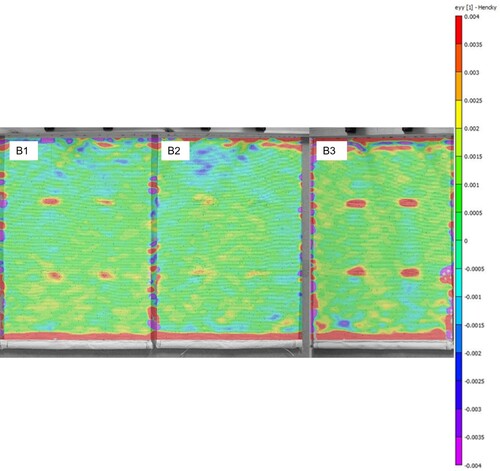
Figure 11. Global longitudinal strain, ϵyy (%), during 168 h of monitoring samples: B1, staggered support lines around the areas of damage; B2, staggered support lines passing through the areas of damage; B3, damaged, untreated sample. RH (%) is indicated by the dotted line.
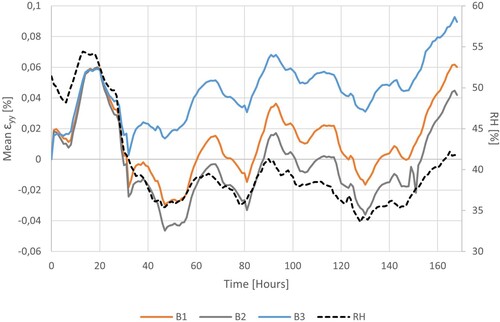
However, these treatments did not completely prevent the damaged areas from opening up. When these global data were compared with the local pseudo-strain data from the damaged areas of samples B1 and B2, shown in , it was clear that the local strain was greater than the overall strain. Although it is not possible to make a direct comparison between the results of different tests, comparing these strain maps with those from a test which combined support lines with couching stitching indicated that adding more intensive stitching resulted in lower local strain across the damaged areas (see Costantini Citation2021, 264).
Test C: comparison of full and patched support, on more damaged sample
The more complex damaged substrate in this test makes the results more difficult to interpret. The four central areas of bare warps were couched to the support in samples C1 and C2: a full support in the case of sample C1 and a patch support in the case of sample C2. The corresponding areas are visible as red patches of relatively high strain on the strain map for the untreated sample C3 but are not visible on samples C1 and C2 (). This showed that both support methods were effective in reducing strain across the treated bare warp areas. The other red areas of high strain highlight unsecured areas of damage; the strain maps show that breaks in the warp (on the right side of the samples) opened up more than breaks in the weft (on the left side of the samples).
Figure 13. Strain maps, ϵyy (%), after 168 h of monitoring of samples: C1, full support with brick and laid couching; C2, patch support with brick and laid couching; C3, damaged, untreated sample. The location of particularly weak areas is marked within dotted lines.
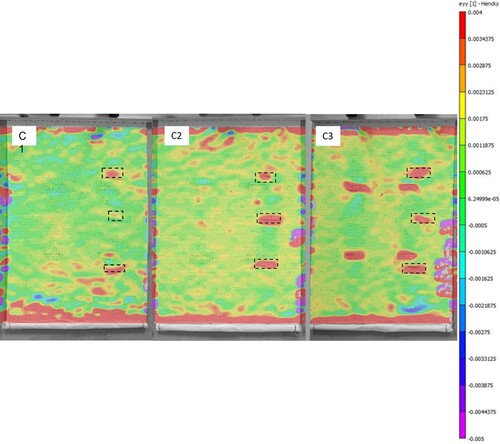
The pseudo-strain data for the main areas of damage () reinforce the difference between the two supported samples and the unsupported sample; both patch and full support result in much lower strain in the local area of damage, with the full support giving slightly better results. However, the global strain graph () highlights that when the central areas of bare warps received just a patch support, the surrounding untreated areas of damage did not benefit at all – the average overall strain shown across sample C2 was similar to that across the sample with no treatment (C3). In comparison, the overall strain in the sample with the full support (C1) was lower; this is also shown in the strain maps. There was still some extension in the untreated areas of C1, but this was reduced by the presence of the linen fabric, even though these areas were not attached to it by stitching.
Test D: tests on tapestry fragment
shows the strain map after 200 h of monitoring following the patched support, the first stage of conservation treatment. The pseudo-strain data, showing the local strain in the damaged areas over this period, are shown in . These both demonstrate the low strain in areas which have been stitched to the linen patches. However it is clear that damaged areas between the patches, and at the edge of the stitching, still show relatively high strain levels. Slit 3, supported by a patch, recorded a negative pseudo-strain during the test, whereas Slit 1, which was not supported, recorded a maximum pseudo-strain of over 0.3%.
Figure 16. Strain map, ϵyy (%), after 200 h of monitoring the tapestry, after the first stage of conservation treatment, patched support. The inner dotted lines show the area of stitching while the outer dashed lines show the edges of the patches (the edges were not secured).
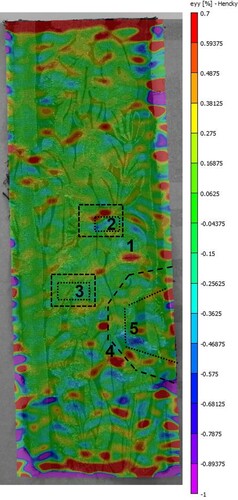
Figure 17. Pseudo strain, ϵyy (%), across damaged areas of the tapestry during 200 h of monitoring after the first stage of conservation treatment, patched support.
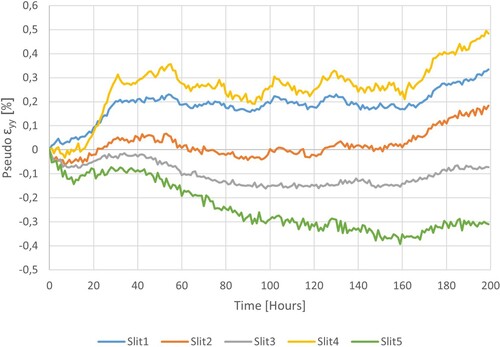
The strain map recorded at the end of a further period of monitoring, after the lower part of the tapestry had been given an additional full support of linen, showed that the additional fabric successfully reduced strain in the areas between the intensive stitching (). The data in shows that Slit 1 now recorded much lower strain, a maximum of 0.05%, similar to the strain shown in other areas. It was supported by the overall grid of stitches, even though it had not been directly stitched to the support fabric. Slit 4, at the bottom edge of the support fabric, still recorded high strain, a maximum of 0.18%, as it was not fully encompassed within the support. Overall, the monitoring of the tapestry fragment confirmed that intensive stitching onto local patches reduced the pseudo-strain in the local area, but not the strain in the areas around the stitching. An overall support onto linen using staggered lines of vertical running stitches was much more successful in reducing extension and hence strain across the whole tapestry if the area of damage was encompassed within the support system.
Discussion
It should be noted that the data obtained from these tests are not statistically significant; few stitched samples could be tested, mainly due to the length of time taken to prepare them, so it was not possible to prepare several samples of the same type of damage and support system in order to understand potential variability in the samples, for example. However, some separate tests looked at similar scenarios, and some samples were tested for a second time, in different combinations. Results could not be directly compared from one test to another, as they related to a particular set of circumstances which could not be replicated, particularly in an uncontrolled environment. However, overall, the test results could be aggregated to build a picture of the mechanisms involved. They gave information in which the researchers could have broad confidence, and which confirmed a textile conservator’s understanding of the physical support process for a damaged textile.
A key finding was that any stitching was helpful in preventing extension across damaged areas. As Asai et al. (Citation2008) also demonstrated, a stitched support appears very effective in restoring strength to a tapestry. The research team also concluded, probably unsurprisingly, that a patch support gives good results if the tapestry is damaged in a discrete area. However, if it is damaged overall, a full fabric support provides better support for weak areas, even if they are not themselves stitched to the support fabric. In terms of structural support, a grid of staggered running stitch lines seems to give good overall support, especially if the stitching passes through damaged areas of the tapestry, though couching in more damaged areas provides additional support.
Intensive stitching in the form of couching was shown to reduce strain in damaged areas by preventing extension. Laid couching appeared to prevent extension to a slightly greater degree than brick couching – this could mean that brick couching is better able to accommodate a tapestry’s expansion and contraction with RH fluctuations. In general, when examining the spacing of couching stitching, it was clear that the closer the stitching, the lower the strain. However, it was felt that the provision of optimum support was not a simple matter of reducing strain as far as possible. By comparing global strain (or strain across the whole sample) with pseudo-strain (or local displacement across the damaged areas) it was clear that very closely spaced stitching resulted in the stitched area showing less strain than the global strain; in other words it constrained the stitched area more than the sample overall. This was felt to be undesirable as different responses to RH could result in local tensions. In the tests on wool rep samples, 16 mm spacing resulted in similar strain results locally and globally (as shown in ), though the ideal spacing would obviously vary from wool rep to tapestry, and from one tapestry to another. The three different spacings of stitching used to support the tapestry fragment showed no significant differences in strain, meaning that the 16 mm spacing was as helpful in reducing strain as the 4 mm spacing. However this was a sole, and limited, trial and further testing would be very useful.
Conclusions for tapestry conservation practice
DIC proved a very valuable resource to examine the effectiveness of tapestry conservation stitching methods; the information provided by this analytical technique was very helpful in providing a visual and numerical comparison of different support approaches. Although it was not possible to determine the precise error associated with the absolute strain values provided by DIC due to uncertainties associated with the use of a non-optimal tracking pattern, they did however enable reliable relative comparisons and the identification of trends in the data. In general it was clear that stitching reduced elongation and strain across areas of damage, as Asai et al. (Citation2008) showed using a different methodology, tensile testing. While both techniques are useful, and Costantini (Citation2021) also employed tensile testing, DIC has the advantage of being a contactless and non-invasive technique. It also allows the investigation of actual self-weight loading, whereas specimens are probably exposed to greater loads during tensile testing. An additional benefit of DIC was the ability to compare global strain across the sample with local pseudo strain in the areas of damage. This indicated that it would be possible to identify the most appropriate stitch technique and spacing for a particular tapestry in order to provide support without changing the properties of the tapestry in discrete areas. A further advantage is that 2D DIC, using a single camera, is inexpensive and is unobtrusive to apply in a museum or historic house setting.
However, it is necessary that users have sufficient expertise or understanding to ensure the optimum set up of the DIC system for each individual situation. The tapestry design should also be checked for suitability with the DIC technique. And as with any analytical technique, the interpretation of the data is key. The project’s two research associates explored the application of DIC for monitoring tapestry. A paper by Alsayednoor et al. (Citation2019) demonstrates how some features, such as large areas of similar colour, can affect camera registration; it also explains the importance of establishing testing parameters, such as subset size, appropriately. A further investigation of these factors has established tools to help conservators and conservation scientists ‘determine the viability, accuracy and reliability of using DIC with tapestries, using the inherent tapestry image to track displacements’ (Nwanoro, Harrison, and Lennard Citation2021, 2). The codes used in this investigation are now freely available for use and can be found in Harrison (Citation2021). It is hoped that tapestry conservators and conservation scientists will trial DIC as a tool for developing tailored conservation treatments.
As discussed in the introduction, tapestry conservation aims to minimise damage caused by both creep, or permanent deformation, and fatigue, caused by repeated expansion and contraction of the fibres. Our investigation clearly showed that damage leads to high levels of strain and that creep is mitigated by stitched support. It also follows that stitching will provide physical support to a tapestry damaged by the effects of fatigue. However, as also noted, tapestry conservation is extremely time-consuming and resource-intensive. This investigation suggests that it is not necessary to carry out very closely spaced stitching to provide good overall support, and here the DIC analytical methodology could allow us to optimise the amount of stitching necessary for a successful support treatment of a tapestry.
It is recognised that stitching is also often carried out for visual reintegration purposes. In this case, it is recommended that the dual aims of the stitching are clearly addressed, distinguishing between stitching carried out to provide structural support and that being used for visual reintegration. The overall result could be to allow tapestry conservators to do less stitching overall, in line with current conservation ethics which highlight the value of minimum intervention (Caple Citation2000, 59–67). While it is now recognised that reversibility is not always achievable for conservation treatments, the overall principle remains and a treatment that supports a tapestry with a smaller amount of stitching would be desirable in these terms – speaking practically, an intensive stitched support is irreversible and the back of the tapestry will not be visible again (Appelbaum Citation1987). The trial support of the tapestry fragment used a two-stage treatment technique, first applying intensive stitching onto support patches, then using staggered lines of stitches to attach an overall support fabric. While not a specific focus of investigation, it was felt that this could be a useful methodology to avoid stitching more intensively into some areas of an overall support, resulting in a mix of stronger and weaker areas across the supported tapestry. It could also be possible to reverse an overall support without disturbing areas of major damage if they had been secured separately. Unless the tapestry is basically sound, it would be necessary in most cases to ensure some kind of full support as the second stage of treatment. A different reinforcing technique – strapping – attaches strips of support fabric at regular intervals; but the support is unrelated to the condition of different areas of the tapestry, and it is felt that on its own this technique leaves alternate strips of tapestry without any support at all.
As also mentioned, a further part of this research project examined the effectiveness of slanted supports for the display of tapestry. Although this study did not look at long-term effects, it concluded that, in the short term at least, friction/adhesion between a tapestry and a textured fabric-covered board ensures effective support when the board is vertical, and that tilting the support at a slight angle (a slant of 5˚ from vertical is often used) confers no additional benefit (Lennard, Costantini, and Harrison Citation2020). Very little has been published on the use of slanted supports for tapestry, though Wild and Brutillot mentioned display on slightly inclined boards to reduce the weight of the tapestry and the tension on the wefts (Citation2006, 181–182). Our tests showed that display on a textured support reduces the effects of fatigue. When this same, unlined, tapestry fragment was suspended against a vertical board half covered in molton, brushed cotton, fabric, for 300 h, the half of the tapestry against the molton fabric was less affected by RH fluctuations than the tapestry on the uncovered board. Contact with the molton fabric reduced expansion and contraction of the tapestry fibres (Lennard, Costantini, and Harrison Citation2020, 9). RH control would also achieve this. It seems less likely that slanted support alone would reduce creep in damaged areas without the addition of stitched support, and it is likely that damage would be caused to weak areas when handling the tapestry, such as when taking it off display. However, as the 2019 questionnaire carried out by Catic revealed, in mainland Europe it is common practice to apply patch supports in damaged areas, usually with laid couching stitching, before displaying a tapestry on a covered board – akin to the dual stitched support suggested above. In short, it appears that both approaches are effective: a full stitched support, and a partial stitched support in combination with a fabric-covered vertical mount.
Ultimately the choice of method depends on the condition of an individual tapestry and its display duration and context. Tapestry conservators often have considerable experience of assessing tapestry condition and tailoring their treatments accordingly. This investigation has aimed to provide further information on a useful methodology which can provide objective data to support these decisions. It is ultimately tapestry conservators who are best able to weigh these factors and the merits of potential treatment approaches to decide on the most appropriate conservation technique.
Acknowledgements
We are grateful to Stephen McCann and Sam Dyer from the University of Glasgow Photo Unit; textile conservator colleagues at Glasgow Museums, Maggie Dobbie, Helen Hughes, and Harriet Woolmore; and to members of the project’s advisory panel.
Disclosure statement
No potential conflict of interest was reported by the author(s).
Additional information
Funding
Notes
1 Now the Kelvin Centre for Conservation and Cultural Heritage Research.
2 The project web page is at: https://www.gla.ac.uk/schools/cca/research/arthistoryresearch/projectsandnetworks/tapestrymodellingandmonitoring/
4 The stitching was carried out by Lennard, an experienced tapestry conservator.
5 A Stabilo OHPen Universal Marker and Sharpie Permanent Marker were used.
6 The camera settings were: 100 ISO, f/8 aperture, exposure time 1/4 s.
7 Vic-2D 2009 by Correlated Solutions. A subset size of 61 and a step size of 5 were selected for all case studies. It is important to select the appropriate subset size as the smaller the subset area, the better the local resolution, but the higher the error. The Hencky strain was calculated using the DIC software and the data were then transferred to MATLAB to allow further analysis.
8 The monitoring and data processing were undertaken by Costantini.
9 The test fabric was used at 90˚ to the orientation of actual tapestry, to utilise the differential thickness of warp and weft yarns. In a woven tapestry, the warp yarns, which are usually horizontal when the tapestry hangs, are thicker than the weft yarns but in the rep fabric, the weft yarns are thicker.
10 As it was only possible to monitor six samples at once, this test did not include a sample of laid couching at 4 mm spacing.
11 It was noted that the couching stitching was more time-consuming (c. 20 h for the three patches compared with c. five hours for the full support).
12 While we were unsure of the precise error associated with the absolute strain values provided by DIC, they did enable us to make reliable relative comparisons and identify trends in the data.
References
- Alsayednoor, J., P. Harrison, M. Dobbie, R. Costantini, and F. S. Lennard. 2019. “Evaluating the Use of Digital Image Correlation for Strain Measurement in Historic Tapestries Using Representative Deformation Fields.” Strain 55 (2), doi:10.1111/str.12308.
- Appelbaum, B. 1987. “Criteria for Treatment: Reversibility.” Journal of the American Institute for Conservation 26 (2): 65–73.
- Asai, K., E. Biggs, P. Ewer, and K. Hallett. 2008. “Tapestry Conservation Traditions: An Analysis of Support Techniques for Large Hanging Textiles.” In ICOM Committee for Conservation 15th Triennial Meeting Preprints, edited by J. Bridgland, 967–975. New Delhi: Allied Publishers.
- Benson, S. J., F. Lennard, and M. J. Smith. 2014. “Like-With-Like’: A Comparison of Natural and Synthetic Stitching Threads Used in Textile Conservation.” In ICOM Committee for Conservation, 17th Triennial Meeting, Preprints, edited by J. Bridgland. Paris: International Council of Museums.
- Bosworth, D., and C. Clark. 2006. “Development of a Couching Technique for the Treatment of Historic Tapestries.” In Tapestry Conservation: Principles and Practice, edited by F. Lennard, and M. Hayward, 91–96. Oxford: Butterworth-Heinemann.
- Bratasz, Ł, M. Łukomski, A. Klisińska-Kopacz, W. Zawadzki, K. Dzierżęga, M. Bartosik, J. Sobczyk, F. Lennard, and R. Kozłowski. 2014. “Risk of Climate-Induced Damage in Historical Textiles.” Strain 5: 1. doi:10.1111/str.12122.
- Brosens, K., and Y. Maes-de Wit. 2019. Tapestry Production & Conservation. 125 Years de Wit. Turnhout: Harvey Miller.
- Caple, C. 2000. Conservation Skills. Judgement, Method and Decision Making. London: Routledge.
- Catic, E. M. 2019. “A Research Project to Measure the Effectiveness of Stitching Methods When Stabilising Weak Areas in Tapestries.” Doctoral thesis University of Glasgow.
- Costantini, R. 2021. “Strain Across Historic Tapestries: A Multi-analytical Investigation on Damage Mechanisms and Conservation Strategies.” Doctoral thesis University of Glasgow. http://theses.gla.ac.uk/82286/.
- Costantini, R., F. Lennard, J. Alsayednoor, and P. Harrison. 2020. “Investigating Mechanical Damage Mechanisms of Tapestries Displayed at Different Angles Using 2D DIC.” European Physical Journal Plus 135: 515. doi:10.1140/epjp/s13360-020-00520-7.
- Harrison, P. 2021. https://github.com/PhilipHarrisonGlasgowUni/SynDIC.
- Hofenk de Graaff, J. H., F. Boersma, and W.H.Th. Roelofs. 1998. Tapestry Conservation: Support Methods and Fabrics for Tapestries. Part I, II and III. Netherlands Institute for Cultural Heritage: Amsterdam.
- Lennard, F., R. Costantini, and P. Harrison. 2020. “Understanding the Role of Friction and Adhesion in the Display of Tapestries on Slanted Supports.” Studies in Conservation, doi:10.1080/00393630.2020.1761184.
- Lennard, F., R. Costantini, and P. Harrison. 2021. “Investigating Tapestry Conservation and Display with Digital Image Correlation.” In Conservation: Out in the Open. The Challenges of Displaying and Conserving Textiles on Open Display. Preprints from the Spring Forum of the ICON Textile Group, 15-20 April 2021, edited by T. Dewhurst, E.-A. Haldane, V. Nicastro, and M. Pardos-Mansilla, 122–132. London: ICON Textile Group.
- Lennard, F., and J. Dulieu-Barton. 2014. “Quantifying and Visualising Change: Strain Monitoring of Tapestries with Digital Image Correlation.” Studies in Conservation 59 (4): 241–255. doi:10.1179/2047058413Y.0000000097.
- Lennard, F., and M. Harper. 2006. “A Grid Support System for The Lamentation Tapestry.” In Tapestry Conservation: Principles and Practice, edited by F. Lennard, and M. Hayward, 97–101. Oxford: Butterworth-Heinemann.
- Lennard, F., and M. Hayward. 2006. Tapestry Conservation: Principles and Practice. Oxford: Butterworth-Heinemann.
- Marko, K. 2020. Woven Tapestry. Guidelines for Conservation. London: Archetype in association with the National Trust.
- Nilsson, J. 2015. “Evaluation of Stitched Support Methods for the Remedial Conservation of Historical Silk Costumes.” e-Conservation Journal 3, doi:10.18236/econ3.201506.
- Nwanoro, K. C., P. Harrison, and F. Lennard. 2021. “Investigating the Accuracy of Digital Image Correlation in Monitoring Strain Fields Across Historical Tapestries.” Strain, doi:10.1111/str.12401.
- Schön, M. 2017. “The Mechanical and Supporting Effect of Stitches in Textile Conservation.” Doctoral thesis, Göteborgs Universitet.
- Sutherland, H., and F. Lennard. 2017. “Each to Their Own? An Investigation into the Spacing of Laid-thread Couching as Used in Textile Conservation.” In: Newsletter of the ICOM Committee for Conservation Working Group of Textiles, 39.
- University of Glasgow. n.d. “From the Golden Age to the Digital Age: Monitoring and Modelling Historic Tapestries.” Accessed 18 October, 2021. https://www.gla.ac.uk/schools/cca/research/arthistoryresearch/projectsandnetworks/tapestrymodellingandmonitoring/.
- Wild, C., and A. Brutillot. 2006. “The Conservation of Tapestries in Bavaria.” In Tapestry Conservation: Principles and Practice, edited by M. Hayward, and F. Lennard, 177–184. Oxford: Butterworth-Heinemann.
- List of suppliers
- Wool rep fabric: Narrow ribbed rep, Context Weavers, Park Mill, Holcombe Rd, Rossendale BB4 4NP.
- Linen: Unprimed linen OV10, https://www.claessenscanvas.com.
- Couching thread: Anchor stranded cotton.
- Thread for running stitch and scrim lines: Gutermann polyester M403.

